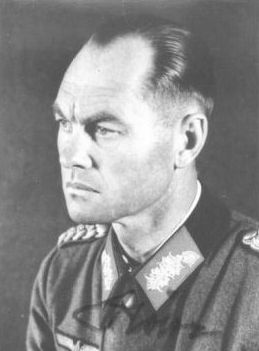Hölter, Hermann
- Date of birth:
- January 31st, 1900 (Lemgo/Lippe, Germany)
- Date of death:
- May 5th, 1989 (Bad Boll/Baden-Württemberg, Germany)
- Nationality:
- German (1933-1945, Third Reich)
Biography
Promotions:
November 7th, 1917: Fahnenjunker;
October 1918: Fähnrich;
August 1st, 1919: Leutnant;
November 1st, 1925: Oberleutnant;
August 1st, 1933: Hauptmann;
January 1st, 1937: Major;
October 1st, 1939: Oberstleutnant im Generalstab;
March 1st, 1942: Oberst im Generalstab;
April 1st, 1944: Generalmajor;
April 20th, 1945: Generalleutnant.
Career:
November 7th, 1917: 10. Württembergisches Infanterie-Regiment Nr. 180;
1919: Schützen-Regiment Nr. 26, Reichsheer;
May 1920: Reichswehr-Infanterie-Regiment 26;
?: 13. (Württ.) Infanterie-Regiment;
April 1st, 1926: Adjutant, II. Bataillons, 13. (Württ.) Infanterie-Regiment;
?: Stab, Gruppenkommando 1;
April 1st, 1929: Adjutant Heeres-Sportschule, Wünsdorf;
1931: Führergehilfenausbildung, Stab, 5. Division, Reichswehr;
October 1st, 1933: Oberkommando des Heeres;
May 1st, 1934: Abteilung T 4, Truppenamt, Reichswehrministerium;
October 12th, 1937: Chef, 10. Kompanie, Infanterie-Regiment 45;
1938: 1. Generalstabsoffizier (Ia), Stab, 34. Infanterie-Division;
September 1940: Taktiklehrer, Deutschen Heeresmission, Rumänien;
June 1941: Chef des Generalstabes, Deutschen General beim Hauptquartier der Finnischen Armee;
October 1st, 1941: Chef des Generalstabes, Höheres Kommando XXXVI;
November 1941: Chef des Generalstabes, Generalkommando XXXVI. Gebirgs-Armeekorps;
November 1st, 1943: Chef des Generalstabes, Generalkommando XIX. Gebirgs-Armeekorps;
February 5th, 1944: Führerreserve OKH;
March 1st, 1944: Chef des Generalstabes, 20. Gebirgsarmee.
Do you have more information about this person? Inform us!
- Period:
- First World War (1914-1918)
- Awarded on:
- June 18th, 1918
- Period:
- First World War (1914-1918)
- Awarded on:
- July 26th, 1918
- Period:
- Second World War (1939-1945)
- Awarded on:
- October 25th, 1939
- Period:
- Second World War (1939-1945)
- Awarded on:
- May 14th, 1940
- Period:
- Second World War (1939-1945)
- Rank:
- Generalmajor (Brigadier)
- Unit:
- Oberkommando, 20. Gebirgs-Armee, Heer
- Awarded on:
- August 17th, 1944
- Period:
- Second World War (1939-1945)
- Awarded on:
- August 24th, 1942
- Period:
- Second World War (1939-1945)
- Rank:
- Generalleutnant (Major-general)
- Unit:
- Chef des Generalstabes, 20. Gebirgs-Armee, Heer
- Awarded on:
- May 3rd, 1945
No evidence regarding the presentation of the Knight's Cross of the Iron Cross to Hermann Hölter can be found in the German Federal Archives. The presumed presentation to Hölter was discussed three times by the order commission of the Association of Knight's Cross Recipients (OdR). The chairman was Walther-Peer Fellgiebel and the ruling in 1976/76 was "no", in 1981/82 "yes 3 May 1945" and "no" again in 1983/84. Fellgiebel chose to list him in his 1986 published book. Apparently Hölter presented his pay book as evidence in 1981. This evidence had been accepted by Fellgiebel at the time. What motivated Fellgiebel to strike him from the list again two years later only to add him again remains unanswered.
A presentation is questionable for two reasons. First, Hitler banned presentation for pure leadership reasons on 10 March 1945. As of this date, the Knight's Cross could only be presented for personal bravery. There was no noteworthy combat in Norway in 1945, and Hölter was a member of the general staff and not in command of any direct combatants. Scherzer states that the presentation date suggests that it is an assumption or manipulation. The presentation date is closely linked to the radio communication for the empowerment for autonomous presentations. Hölter was a member of the OdR.
- Period:
- Second World War (1939-1945)











